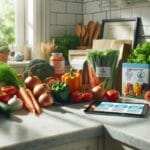8 Ways To Stretch Your SNAP Money If Benefits Were To Ever Get Cut
Updated for 2025 | By Your Name
As food prices continue to rise and government programs face ongoing scrutiny, many SNAP (Supplemental Nutrition Assistance Program) recipients are concerned about the possibility of benefit reductions. According to a recent AOL.com article, millions of Americans rely on SNAP to put food on the table, and any reduction in benefits could have a significant impact on household budgets.
For those with food sensitivities or dietary preferences, stretching SNAP dollars can be even more challenging. Fortunately, there are practical strategies and modern tools that can help you make the most of your benefits, even in the face of potential cuts. Here are eight proven ways to maximize your food budget while maintaining a healthy, personalized diet.
1. Plan Your Meals and Shop With a List
Meal planning is the cornerstone of smart grocery shopping, especially when every dollar counts. According to a 2024 study by the Journal of Nutrition Education and Behavior, families who plan meals in advance reduce food waste and spend up to 20% less on groceries.
- Start by reviewing weekly grocery store flyers and SNAP-eligible discounts.
- Build your meals around sale items and seasonal produce.
- For those with food allergies or sensitivities, use apps like Food Scan Genius or Yuka to scan product barcodes and verify ingredients before adding them to your list.
By sticking to your list and avoiding impulse purchases, you can ensure your SNAP dollars go further, and you’re only buying what fits your dietary needs.
2. Buy in Bulk and Cook from Scratch
Bulk buying is a tried-and-true method for saving money, particularly on staple foods like rice, beans, oats, and frozen vegetables. Cooking from scratch not only stretches your budget but also gives you full control over ingredients—a crucial factor for people with food sensitivities or special diets.
- Look for bulk bins at local grocery stores, food co-ops, or warehouse clubs that accept SNAP.
- Prepare large batches of meals and freeze portions for later use.
- Use ingredient scanning apps to ensure bulk items are safe for your dietary requirements.
Research from the USDA Economic Research Service in 2024 found that households cooking from scratch save an average of $60 per month compared to those relying on pre-packaged foods.
3. Take Advantage of Double-Up Food Bucks and Local Programs
Many states offer programs that match SNAP dollars spent on fresh fruits and vegetables at participating farmers markets and grocery stores. The Double-Up Food Bucks program, for example, allows you to double your produce purchases at no extra cost.
- Find participating markets in your area through your state’s SNAP website.
- Ask market vendors about additional discounts for SNAP users.
- For those with food allergies, farmers markets offer the opportunity to ask growers directly about their farming practices and potential allergens.
These programs not only stretch your SNAP benefits but also support local agriculture and provide access to fresher, healthier foods.
4. Embrace Store Brands and Generic Products
Store brands and generic products are often significantly cheaper than name brands and can be just as nutritious. For people with dietary restrictions, it’s important to read labels carefully, as ingredients can vary.
- Use apps like Yuka to scan and compare the nutritional quality and ingredient safety of store brand products.
- Check for allergen warnings and manufacturing practices.
- Don’t hesitate to contact store customer service for detailed ingredient information if needed.
A 2024 FoodNavigator-USA report notes that private label (store brand) foods have gained market share due to improved quality and affordability, making them a smart choice for SNAP recipients.
5. Leverage Technology: Food Scan Genius and Yuka
Navigating food labels can be overwhelming, especially for those managing allergies, intolerances, or specific dietary preferences. Apps like Food Scan Genius and Yuka empower shoppers by providing instant access to detailed ingredient and nutrition information.
- Food Scan Genius: Scan barcodes to check for allergens, additives, and compliance with your dietary needs (gluten-free, vegan, etc.).
- Yuka: Offers a simple health rating for products and flags potentially harmful ingredients, helping you make informed choices within your budget.
These tools are especially helpful for SNAP recipients who must avoid certain foods and want to maximize both their health and their spending power.
6. Utilize Community Resources and Food Pantries
Food pantries, community kitchens, and charitable organizations can supplement your grocery budget, especially if SNAP benefits are reduced. Many pantries now offer options for those with food allergies or dietary preferences.
- Contact local food banks to ask about allergy-friendly or specialty diet boxes.
- Join community meal programs that cater to specific dietary needs.
- Check for pop-up pantries and mobile food distributions in your area.
According to Feeding America, demand for food pantry services increased by 18% in 2024, highlighting the importance of these resources for families facing food insecurity.
7. Grow Your Own Food—Even In Small Spaces
Home gardening is a sustainable way to supplement your food supply and reduce grocery costs. Even if you have limited space, container gardening or window herb boxes can yield fresh produce year-round.
- Start with easy-to-grow items like lettuce, tomatoes, herbs, or peppers.
- Look for community gardens that offer free plots and gardening classes for SNAP recipients.
- Some states allow SNAP benefits to be used for purchasing seeds and plants that produce food.
A 2024 Gardening Know How survey found that home gardeners save an average of $300 per year on produce, making it a valuable strategy for stretching your food budget.
8. Learn to Preserve and Store Food Safely
Preserving food through freezing, canning, or dehydrating allows you to take advantage of sales and bulk purchases without worrying about spoilage. This is especially important for those with dietary restrictions who may need to stock up on safe foods when they’re available.
- Invest in basic supplies like freezer bags, canning jars, or a dehydrator (often available at thrift stores or through community programs).
- Follow safe food handling and preservation guidelines from the USDA or your local extension office.
- Label and date stored foods to minimize waste and ensure food safety.
Proper food storage can extend the shelf life of your groceries and help you weather periods of reduced SNAP benefits or unexpected expenses.
Addressing Food Sensitivities and Dietary Preferences on a Budget
Managing food sensitivities, allergies, or special diets (such as gluten-free, dairy-free, or vegan) can be more expensive, but it’s not impossible on a tight budget. Here are a few extra tips:
- Focus on naturally allergen-free whole foods like fruits, vegetables, rice, and beans.
- Use technology like Food Scan Genius and Yuka to avoid hidden allergens or additives.
- Connect with local support groups for recipe ideas and information on affordable specialty products.
- Check for manufacturer coupons and rebates on allergy-friendly brands.
Recent research published in the Journal of the Academy of Nutrition and Dietetics in late 2023 found that technology-assisted shopping improved both dietary adherence and cost savings for people with food allergies.
Conclusion: Maximizing Your SNAP Benefits in 2025 and Beyond
While the future of SNAP benefits may be uncertain, proactive planning and smart strategies can help you weather potential cuts. By meal planning, buying in bulk, leveraging technology, and tapping into community resources, you can stretch your SNAP dollars and maintain a healthy, personalized diet—no matter your dietary needs.
For more tips and updates on SNAP benefits, visit the official USDA SNAP website and stay informed about local programs in your area.
Remember: You are not alone. There are resources, tools, and a supportive community ready to help you make the most of your food budget, even if benefits are reduced.





